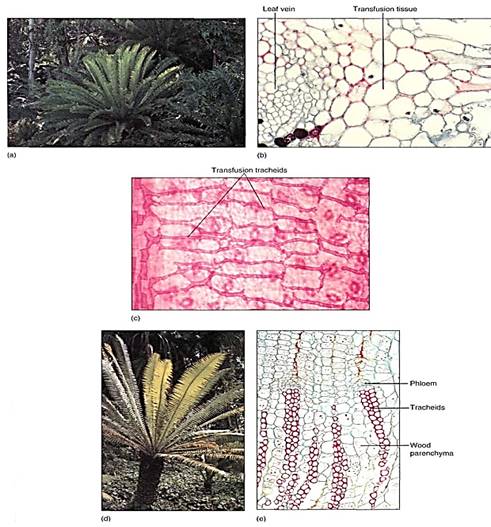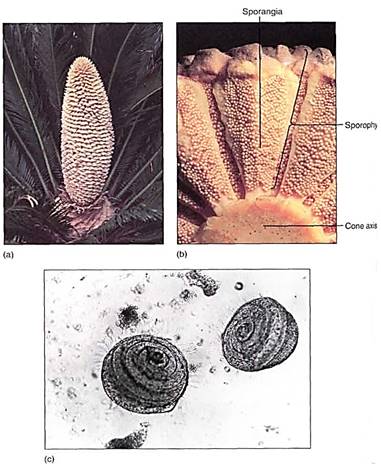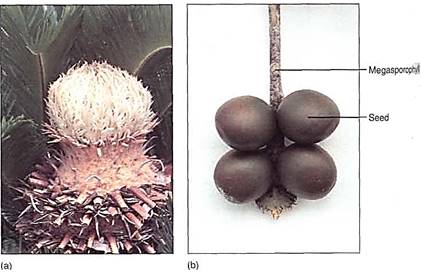


 النبات
النبات
 الحيوان
الحيوان
 الأحياء المجهرية
الأحياء المجهرية
 علم الأمراض
علم الأمراض
 التقانة الإحيائية
التقانة الإحيائية
 التقنية الحيوية المكروبية
التقنية الحيوية المكروبية
 التقنية الحياتية النانوية
التقنية الحياتية النانوية
 علم الأجنة
علم الأجنة
 الأحياء الجزيئي
الأحياء الجزيئي
 علم وظائف الأعضاء
علم وظائف الأعضاء
 الغدد
الغدد
 المضادات الحيوية
المضادات الحيوية|
Read More
Date: 24-11-2016
Date: 23-11-2016
Date: 27-11-2016
|
Division Cycadophyta: Cycads
Modern cycads are frequently confused with either ferns or young palm trees because they have stout trunks with pinnately compound leaves (Table , Fig. 1). Most cycads are short plants less than 1 or 2 m tall, but Macrozamia can reach heights of 18 m. The trunk is covered with bark and persistent leaf bases that remain on the plant even after the lamina and petiole have abscised. Internally, cycad stems are similar to those of seed ferns—a thick cortex containing secretory ducts surrounds a small amount of parenchymatous wood. Tracheids are long and wide, and rays are massive. Even very old stems have only a small amount of wood; most support is provided by the tough leaf bases. A prominent pith contains secretory canals.


FIGURE 1: Aspects of the vegetative body of cycads. (a) Cycads tend to have short, stout trunks with tough, leathery, pinnately compound leaves that superficially resemble leaves of ferns or palms (Cycas revoluta). (J. L Castner) (b) Cycad leaf veins have transfusion tissue similar to that in conifer leaves (X50). (c) Transfusion tracheids extend from veins into the leaf blade. Stomata are visible, slightly out of focus, in the lower epidermis (X 32). (d) Some cycads such as this Dioon spinulosum do become large, but only if they become extremely old. (Robert and Linda Mitchell) (e) Cycads have secondary growth, but only small amounts of wood and phloem are produced, so the trunks do not become very much wider with age. The xylem is of the parenchymatous type (X 32).
Unlike seed ferns, cycad foliage leaves do not bear ovules. Instead, cycads produce seed cones and pollen cones, each on separate plants; cycads are always dioecious. Pollen cones consist of spirally arranged shield-shaped microsporophylls that bear clusters of microsporangia (Fig. 2). Upon germination, pollen grains produce a branched pollen tube and large, multiflagellate sperm cells. Seed cones are variable, with those of Cycas revoluta usually considered the most relictual (Fig. 3). In this species the seed cone is a large, loose aggregation of leaf-like, pinnately compound megasporophylls. Six to eight large ovules occur near the base, but the upper half of the megasporophyll is rather leaf-like, similar to the ovule-bearing organs of some seed ferns. Megasporophylls of the cycad Zamia floridana are considered more derived. They are shield-shaped and bear only two ovules, and the entire cone is quite compact. Cycad ovules are like those of seed ferns, having a large, vascularized megasporangium and a loosely attached, vascularized integument.
Although Cycadophyta was a much larger group with many more species in earlier times, at present it contains nine or ten genera and about 100 species. Modern cycads are highly prized ornamentals in the warmest parts of the United States; only a few can withstand freezing temperatures in winter. They are almost all tropical with an unusual distribution: Some occur in Cuba and Mexico, others in Australia, still others in southeast Asia or Africa. Cycads are now believed to have been widespread and to have occupied many habitats, but in most areas they have become extinct. The few remaining, widely scattered species are the survivors of a formerly extensive group.

FIGURE 2: (a) Pollen cones of cycads tend to be large, more than 30 cm long, like this one of Cycas circinnalis. It is a simple cone, with one axis that bears microsporophylls. (J. L. Castner) (b) Microsporophylls in cycads may bear many microsporangia. (c) Sperm cells of cycads have hundreds of flagella and must swim to the egg call. Zamia (X 165). (K. Norstog, Fairchild Tropical Gardens).

FIGURE 3: (a) Seed cones of cycads differ greatly from those of conifers; they are simple, they have only one axis, and the megasporophylls are borne on that axis. They have no bracts or axillary buds. (Robert and Linda Mitchell) (b) Cycad megasporophylls are not fused structures as is the ovuliferous scale of conifers; instead, the megasporophyll is simple and strongly resembles a foliage leaf, at least in Cycas circinnalis. It is not difficult to see how this type of sporophyll could evolve from a seed fern sporophyll .



|
|
|
|
التوتر والسرطان.. علماء يحذرون من "صلة خطيرة"
|
|
|
|
|
|
|
مرآة السيارة: مدى دقة عكسها للصورة الصحيحة
|
|
|
|
|
|
|
نحو شراكة وطنية متكاملة.. الأمين العام للعتبة الحسينية يبحث مع وكيل وزارة الخارجية آفاق التعاون المؤسسي
|
|
|